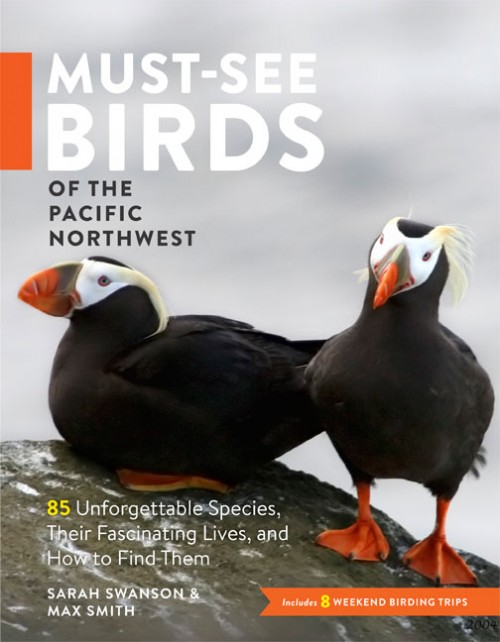Must-See Birds of the Pacific Northwest

Upcoming events:
North Cascades Institute’s Birds of Bellingham Bay outing on the Snow Goose; Oct. 5, 8 am-5 pm, $125. Info and registration at ncascades.org or (360) 854-2599
Sarah Swanson and Max Smith presentation at Village Books in Bellingham; Oct 2, 7 pm, free. Info at villagebooks.com
Sarah Swanson and Max Smith, passionate birders living in Portland, have created a fantastic new natural history guidebook with Timber Press called Must-See Birds of the Pacific Northwest. Unlike other guides, Must-See Birds doesn’t attempt to describe every winged creature in our region but instead hones in on 85 species that provide a rich cross-section of the avian riches unique to Washington and Orgeon. Divided in to sections like “Beach Birds,” “Big Birds,” “Tree Trunk Birds” and “Urban Birds,” their tome tells the stories of each species, illustrated by sumptuous photographs and, most helpful, where to find them. It closes with eight distinct weekend birding trip itineraries, including “Nesting Season on the Central Oregon Coast,” “The Canyon Country of Central Washington” and “The Salish Sea in Winter.”
Swanson and Smith will bring their book to life when they join local bird authority Joe Meche to lead a day-long “Avifauna Afloat” exploration of Bellingham Bay aboard the Snow Goose with North Cascades Institute on October 5. We talked with them about Must-See Birds ahead of their visit.
Christian Martin: How did you determine what birds in the Northwest are “must see”?
Sarah Swanson: The 85 birds in the book are ones that should excite birders and ones that they should be able to find and identify without too much trouble. We included species with interesting plumage and behavior and excluded ones that are too rare (Snowy Owl) or hard to identify for beginners (Pacific-slope Flycatcher).
CM: What is the larger goal of creating this guide?
SS: We want to get more people out birding and to help them expand their birding horizons geographically and taxonomically. The more that people enjoy birds and birding, the more they will do what they can to help protect birds and their habitats.
CM: What is unique about birds in our region?
SS: Birding here is unique for several reasons. For one, we have a whole family of birds—the alcids—that are only found in northern coastal areas and include puffins and tree-nesting Marbled Murrelets. Another is how the temperate winters here make for excellent birding when other parts of the country are covered in snow. All you need are waterproof binoculars and a raincoat.
CM: All of these great, specific birding trips you’ve provided in the book—where to go to see different species at different times of years—seems like a lot of work!
SS: We include roughly 200 birding sites in the book and it did indeed take a lot of work to determine the best places to find each bird. The list of sites is a combination of our favorite birding spots and new places that we researched and then scouted in person. Our knowledge of the region has definitely grown over the last two years and we especially enjoyed seeing new parts of Washington.
CM: What do you look forward to on your upcoming birding trip on Bellingham Bay?
SS: We always look forward to birding the Salish Sea because there is nothing like it in Oregon. The chance to see seabirds and other waterfowl in protected water instead of rolling in the ocean swells is well worth the trip. We hope to see large flocks of Brant, tiny Marbled Murrelets and maybe an early Long-tailed Duck. We enjoy passing on simple ID tips and bird facts that will stick with people for their next trip and love it when someone gets really excited about identifying a bird, such as a gull, that they may have ignored before the trip.
Follow Sarah and Max’s birding adventures around the Northwest at http://mustseebirds.blogspot.com/

